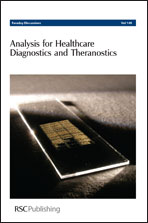Peptide-tags for enhanced DNA microarray performance†
Abstract
DNA microarrays are powerful tools for gene expression analysis and genotyping studies in research and diagnostic applications. A high sensitivity and short time-to-result are prerequisites for their practical application in the clinic. The hybridization efficiency of DNA microarrays depends on the probe density and the probe orientation and thus their accessibility for target molecules. In order to find an optimal probe immobilization procedure a set of different
- This article is part of the themed collection: Analysis for Healthcare Diagnostics and Theranostics

 Please wait while we load your content...
Please wait while we load your content...